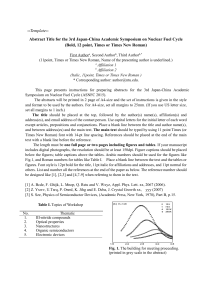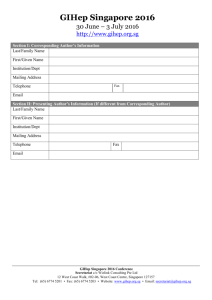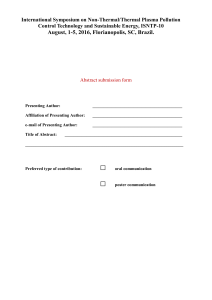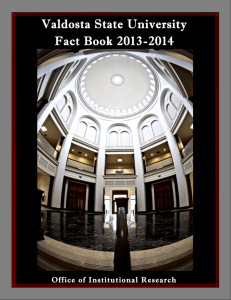Typing Guidelines For Preparing The Manuscripts Of The
advertisement
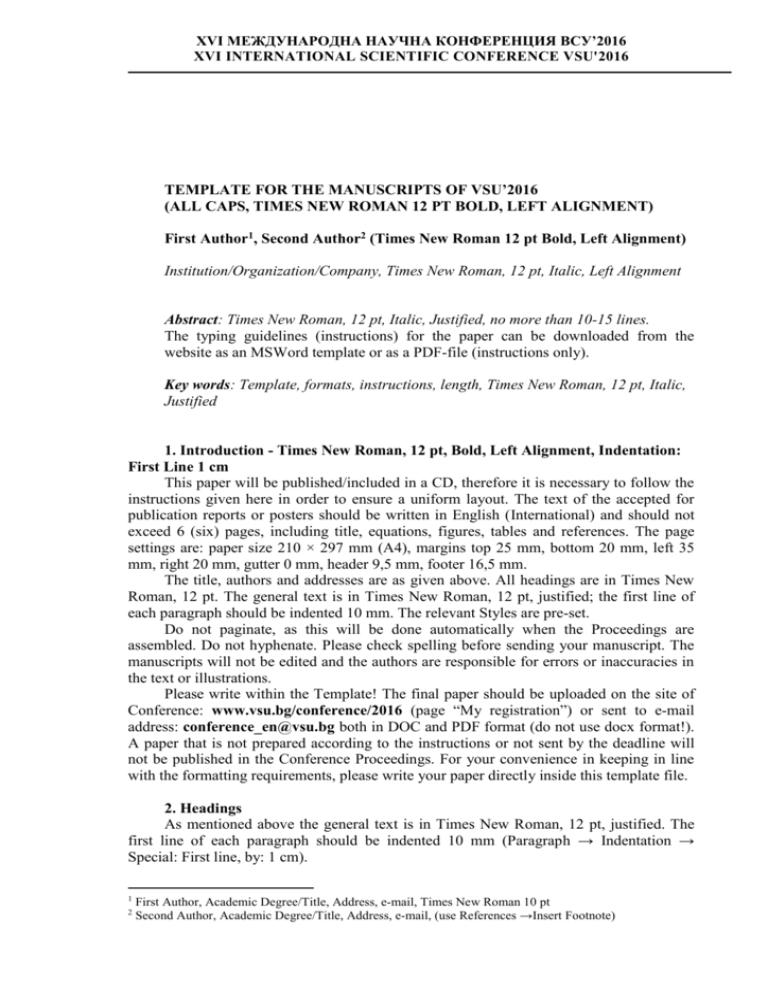
XVI МЕЖДУНАРОДНА НАУЧНА КОНФЕРЕНЦИЯ ВСУ’2016 XVI INTERNATIONAL SCIENTIFIC CONFERENCE VSU'2016 TEMPLATE FOR THE MANUSCRIPTS OF VSU’2016 (ALL CAPS, TIMES NEW ROMAN 12 PT BOLD, LEFT ALIGNMENT) First Author1, Second Author2 (Times New Roman 12 pt Bold, Left Alignment) Institution/Organization/Company, Times New Roman, 12 pt, Italic, Left Alignment Abstract: Times New Roman, 12 pt, Italic, Justified, no more than 10-15 lines. The typing guidelines (instructions) for the paper can be downloaded from the website as an MSWord template or as a PDF-file (instructions only). Key words: Template, formats, instructions, length, Times New Roman, 12 pt, Italic, Justified 1. Introduction - Times New Roman, 12 pt, Bold, Left Alignment, Indentation: First Line 1 cm This paper will be published/included in a CD, therefore it is necessary to follow the instructions given here in order to ensure a uniform layout. The text of the accepted for publication reports or posters should be written in English (International) and should not exceed 6 (six) pages, including title, equations, figures, tables and references. The page settings are: paper size 210 × 297 mm (A4), margins top 25 mm, bottom 20 mm, left 35 mm, right 20 mm, gutter 0 mm, header 9,5 mm, footer 16,5 mm. The title, authors and addresses are as given above. All headings are in Times New Roman, 12 pt. The general text is in Times New Roman, 12 pt, justified; the first line of each paragraph should be indented 10 mm. The relevant Styles are pre-set. Do not paginate, as this will be done automatically when the Proceedings are assembled. Do not hyphenate. Please check spelling before sending your manuscript. The manuscripts will not be edited and the authors are responsible for errors or inaccuracies in the text or illustrations. Please write within the Template! The final paper should be uploaded on the site of Conference: www.vsu.bg/conference/2016 (page “My registration”) or sent to e-mail address: conference_en@vsu.bg both in DOC and PDF format (do not use docx format!). A paper that is not prepared according to the instructions or not sent by the deadline will not be published in the Conference Proceedings. For your convenience in keeping in line with the formatting requirements, please write your paper directly inside this template file. 2. Headings As mentioned above the general text is in Times New Roman, 12 pt, justified. The first line of each paragraph should be indented 10 mm (Paragraph → Indentation → Special: First line, by: 1 cm). 1 2 First Author, Academic Degree/Title, Address, e-mail, Times New Roman 10 pt Second Author, Academic Degree/Title, Address, e-mail, (use References →Insert Footnote) XVI МЕЖДУНАРОДНА НАУЧНА КОНФЕРЕНЦИЯ ВСУ’2016 XVI INTERNATIONAL SCIENTIFIC CONFERENCE VSU'2016 2.1. Subheading Leave one blank line before the subheading (subsection), but after the subheading does not leave a blank line. 2.2. Equations Displayed equations, expressions or formulas should be left alignment, set on a separate line and numbered as follows: section number and equation number. Leave one blank line before and after the equation/expression/formula. For example (2.1) RT 1 c , E where variables or symbols should be defined, unless obvious. Use a reputable equation editor. 3. Experimental results 3.1. Figures and Tables Please produce your figures electronically and integrate them into manuscript. The grids and details within the figures must be clearly readable. The line drawings and pictures should have a resolution of at least 200 dpi before inserting into your text file. The lettering in figures should have a height of (12-point type, any font). Figures with proffered format of jpg, jpeg, bmp should be embedded in the text. They must be anchored in the text (Format Picture → Layout → In line with text). The figures and tables are separated by a blank line from the body text and should be inserted as close as possible to the text they refer to. They should be numbered and should have a caption, which should always be cantered under the figures (Fig. 1), in contrast to the caption belonging to a table, which should always positioned above the table (Tabl. 1). Please, refer to figures or tables in the text as Fig. 1, Fig. 2 (Tabl. 1, Tabl. 2). The text in the tables should be 10-12 pt; Times New Roman a) b) c) Fig. 1. Figure caption: а) explanation; b) additional information; c) technical data (photo by L. Hrischev) [1] XVI МЕЖДУНАРОДНА НАУЧНА КОНФЕРЕНЦИЯ ВСУ’2016 XVI INTERNATIONAL SCIENTIFIC CONFERENCE VSU'2016 Table 1. Levels of vibration Vibration levels in dB in the Adjusted octave bands of frequency Levels Purpose of the Room Time, h 16 Hz 31.5 Hz 63 Hz 7-23 72/86 72/92 72/98 72/74 Apartment 23-7 67/81 67/87 67/93 67/72 Offices 75/89 75/95 75/101 75/80 Note: in notation 72/86, 72 is the vibrational velocity, and 86 – vibrational acceleration. 3.2. Units The SI units are strongly encouraged. The combining SI and CGS units must be avoided. This often leads to confusion because equations do not balance dimensionally. If you must use mixed units, clearly state the units for each quantity in an equation. Conclusion A conclusion section is not required, although in the conclusion the main points of the paper may be reviewed. Do not replicate the abstract as the conclusion. A conclusion might elaborate on the importance of the work or suggest applications and extensions. Leave two blank lines before the conclusion(s) as well as before the references sections. References (books, articles, etc.) should be quoted in the text by numbers in square brackets - [1], [2], etc. - and grouped together at the end of the paper in numerical order as shown in these instructions. Order the references following their first appearance in the text. Appendix The appendices, if needed, appear before the acknowledgment. Acknowledgement The acknowledgement, if any, is placed at the end of the paper text, without numbering. This is the correct place for sponsor and financial support acknowledgments. [1] [2] [3] [4] REFERENCES Lyons A. Materials for Architects and Builders, 4th Edition, Butterworth-Heinemann, 2010, 440 p. Roussel N. Steady and transient flow behaviour of fresh cement pastes, Cem. Concr. Res. 35, 2005, 1656–1664. Tchobanov V., K. Ishtev, P. Philipoff. Investigation of the Structural Dynamic Behaviour in Complex Domain, Stroitelstvo, Sofia, 6-7, 1994, 13-21. (in Bulgarian) Regel V.R, A.I. Slutzker, E.E.Tomashevskii. Kinetic Nature of Strength of Solids, Nauka, Moscow, 1974, 560 p. (in Russian)
